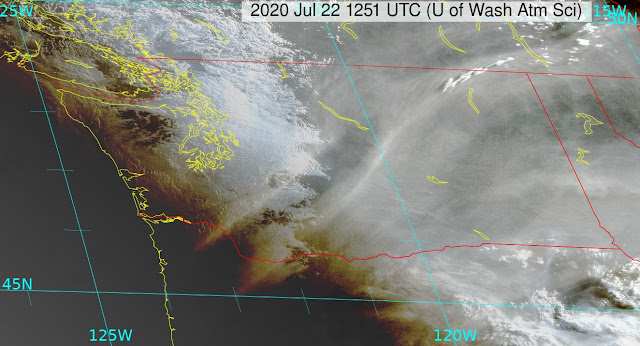From what? Our huge volcanic peaks.
Shadow of Mountain Rainier by Troy Mason through a Creative Commons License
During the past few weeks I have been viewing some of the early morning imagery from the NOAA/NWS GOES-West weather satellite, which has far higher resolution sensors than previous generation satellites. And the shadows one can see are amazing.
Consider yesterday, July 21. Here are the GOES visible images at 5:51 and 5:56 AM. Wow.
In the first picture, the shadow of Mount Rainer extends at least all the way to the Columbia River, 92 miles (149 km) away. Other major volcanic peaks, such as Adams and Hood also project impressive shadows.
Our mountains are actually well-situated to produce long shadows..they are very high compared to their surroundings and there is a major low area (eastern WA) to their east.
The Seattle PanoCam at 5:30 AM actually shows the shadow from the side.
We clearly possess world-class mountain shadows, although other countries and regions do claim the big-shadow mantle (see below). Rainier is higher than Mount Teide by a lot.
Are the volcanic shadows the longest observed over the Northwest? I don't think so.
What is even higher than our volcanic peaks? Clouds. And clouds can project amazing shadow.
Here is an example from July 19th at 5:51 AM. High cirrus clouds over eastern Washington are projecting shadows that extended into western Washington. Amazing. We are talking about shadows that are at least 160 miles long.
This morning the shadow action is not so good, with low clouds surging into western Washington and Oregon (see below). And there is something else: wildfire smoke has entered the region, mainly from fires over California. But more about that in a future blog.









When I lived outside of Aspen for a few years, I was struck how often the shadows fron the encircling peaks affected the general climate. I started to feel claustrophobic after awhile, it's beautiful of course but closed in as well.
ReplyDeleteThanks for sharing these images. This is an unusual topic to look into, but still very interesting.
ReplyDeleteAside from the length of the shadows, it hadn't occurred to me before that sometimes clouds I see near the horizon might be 160+ miles away, on the other side of the mountains, and even in a different climate zone.
Very cool, Cliff!
ReplyDeleteI'm fascinated with Mount Ranier in general and visit there as often as I can. My preference is to spend my time and attention on nature.
Very cool, Cliff!
ReplyDeleteI'm fascinated with Mount Ranier ever since the first time my plane flew over it. Thanks for posting this fun fact--it just adds to my interest.
I like to watch the shadows from the volcanoes on the Antillies.
ReplyDeletehttps://cdn.star.nesdis.noaa.gov/GOES16/ABI/SECTOR/car/GEOCOLOR/1000x1000.jpg
Our home NW of Longview is in a curious place, our very own super-Stonehenge. The equinoctal sun rises over St. Helens, and Rainier stands very near the solstice point. Since sunrise is such a shallow angle, and a clear morning on 21 June so rare, I can't quite be sure the sun doesn't rise slightly left of Raininer. Oh well: close enough!
ReplyDelete